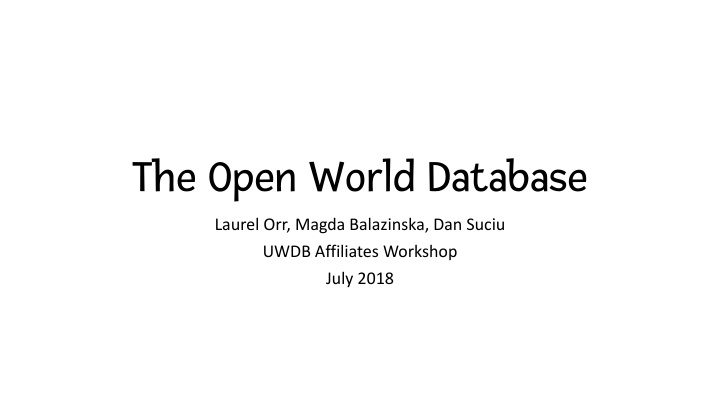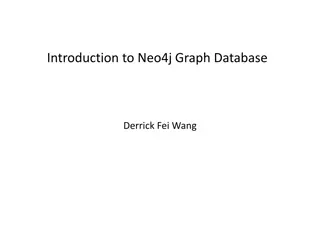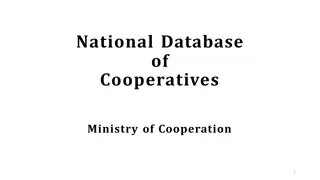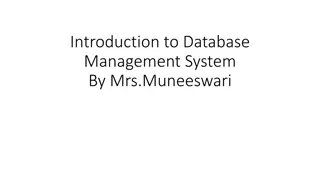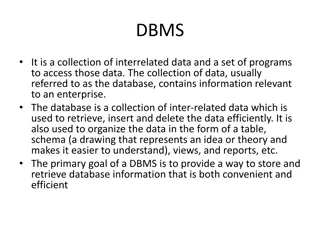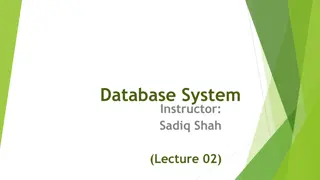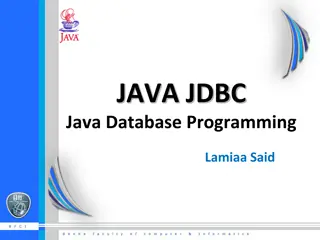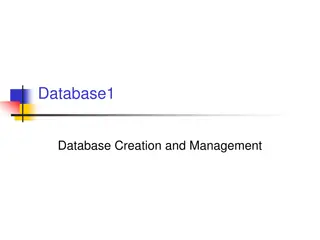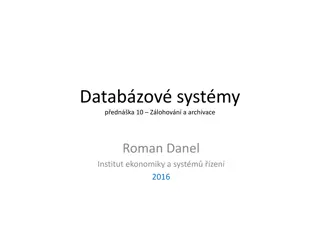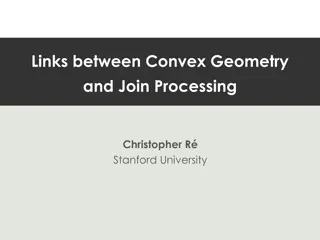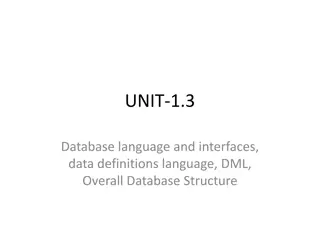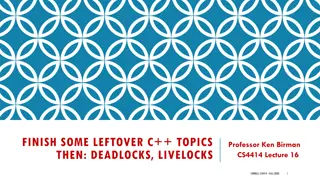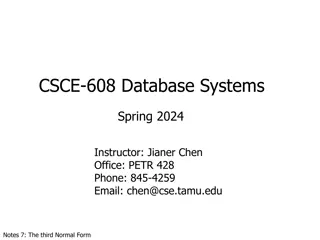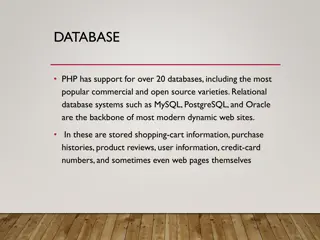Building Open World Database System
Scientists analyze biased data samples to learn about populations. Databases need to adapt to assume data as a biased sample, even if sampling is unknown. User interaction helps correct sample bias, with an ongoing solution in progress.
Download Presentation

Please find below an Image/Link to download the presentation.
The content on the website is provided AS IS for your information and personal use only. It may not be sold, licensed, or shared on other websites without obtaining consent from the author.If you encounter any issues during the download, it is possible that the publisher has removed the file from their server.
You are allowed to download the files provided on this website for personal or commercial use, subject to the condition that they are used lawfully. All files are the property of their respective owners.
The content on the website is provided AS IS for your information and personal use only. It may not be sold, licensed, or shared on other websites without obtaining consent from the author.
E N D
Presentation Transcript
The Open World Database Laurel Orr, Magda Balazinska, Dan Suciu UWDB Affiliates Workshop July 2018
Science is Samples
Three Types of Sampling Known Population, Known ? Unknown Population, Known ? Unknown Population, Unknown ? Population Population Population Sample with known Mechanism ? Sample with known Mechanism ? Sample with unknown Mechanism ? Sample Sample Sample Pro: faster queries Con: loses accuracy Pro: faster queries, manageable data Con: loses accuracy Pro: faster queries, manageable data Con: loses accuracy, unknown ?
Enter the Database , Known ? Known Population Assumes the data is the entire population (e.g., a data warehouse) Population Sample with known Mechanism ? Provides sampling operators Sample Lead to a lot of great research making population queries faster
Our Target Audience Three Types of Sampling Known Population, Known ? Unknown Population, Known ? Unknown Population, Unknown ? Population Population Population Sample with known Mechanism ? Sample with known Mechanism ? Sample with unknown Mechanism ? Sample Sample Sample Pro: faster queries Con: loses accuracy Pro: faster queries, manageable data Con: loses accuracy Pro: faster queries, manageable data Con: loses accuracy, unknown ?
Motivating Example Unknown Sampling Mechanism 704,352 Seattletonians 10 min/person = What is the average age of people in Seattle who have gotten a texting/phone citation? 11 years Survey of 100 People Living in the U District Selection Bias 5/100 people got phone tickets with average age of 26 Databases Should Correct This Answer This implies ~35,000 phone tickets in Seattle, but WA reported that ~33,000 tickets given. How can this be? (or at least say it has error)
To Summarize Claim: Scientists analyze (often biased) data samples to learn about the population as a whole. Problem: Databases assumed a closed world (the data is NOT a sample). Goal: Build an Open World Database system that natively assumes data ingested is a biased sample of some population, even if the sampling mechanism is unknown. Allow for user interaction to determine best technique to correct for sample bias. Solution: (work in progress )
What about Probabilistic Databases? Probabilistic Databases: - Can assume an open world - Probabilities measure uncertainty in data (e.g., data scraped from possibly unreliable web sources) Sample data is certain data, but not all the certain data is contained in the database.
If Sampling Mechanism is Known If we know ?, then we know the probability with which each tuple was sampled. A B C A B C _weight 1/?(?1) a1 b2 c1 a1 b2 c1 Reweight each tuple with the inverse of its sample probability 1/?(?2) a1 b1 c3 a1 b1 c3 1/?(?3) a2 b3 c2 a2 b3 c2 1/?(?4) a3 b3 c3 a3 b3 c3 If we do not know ?, how can we still determine sample probability?
Logisitic Regression Idea: classify tuples as being in sample (1) or not (0) using logistic regression on tuple attributes. A B C _class A B C _weight 1/??(?1) a1 b2 c1 1 a1 b2 c1 1/??(?2) a1 b1 c3 1 a1 b1 c3 1/??(?3) a2 b3 c2 1 a2 b3 c2 1/??(?4) a3 b3 c3 1 a3 b3 c3 a1 b1 c1 0 a3 b3 c1 0 Problem: the 0 labelled data does not exist or is challenging to access. a2 b2 c2 0 a2 b1 c2 0
What Else do We Know? This implies ~35,000 speeding tickets in Seattle, but WA reported that ~33,000 tickets given. How can this be? given. How can this be? C This implies ~35,000 speeding tickets in Seattle, but WA reported that ~33,000 tickets WA reported aggregates without releasing the data For tuple ??, ???? ??= ?0+ ?1?.? + ?2?.? + ?3?.? + ? A B a1 b2 c1 Idea: use linear regression to model the weights constrained by the given aggregates. a2 b3 c2 sample aggregates and actual aggregates. a1 b1 c3 Minimize sum squared error between weighted a3 b3 c3 2 4 + ???? ?1 52 ???? ?? 25 25 rows in population 5 rows of (a1, b2, *) ?=1 Note: we assume the weight is a linear combination of the attributes
Open Questions How can we add in user interaction or partial information about the sampling mechanism? Is a linear model adequate to model the weight? How does our accuracy change given our set of aggregates? What if we have multiple samples instead of just one? How do we handle error?
